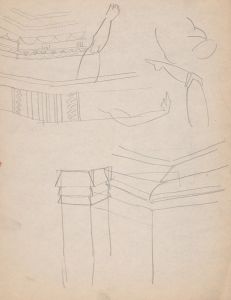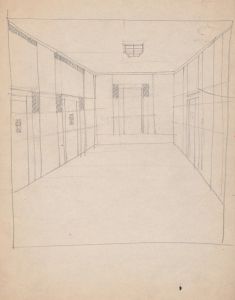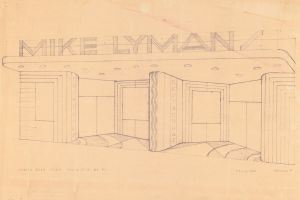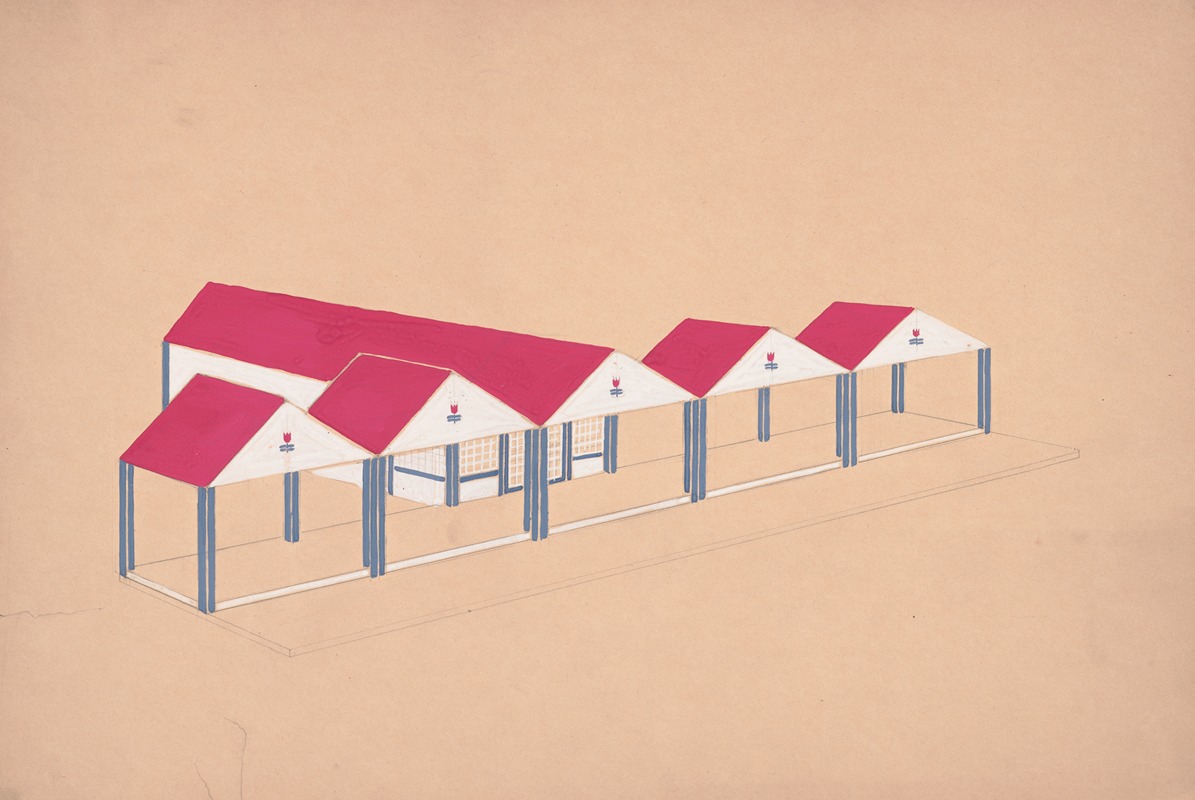
[Designs for roadhouse or terrace restaurant.] [Scheme [B] with a T-plan, 5- bays, with painted tulips in the pediments.
A hand-painted replica of Winold Reiss’s masterpiece [Designs for roadhouse or terrace restaurant.] [Scheme [B] with a T-plan, 5- bays, with painted tulips in the pediments., meticulously crafted by professional artists to capture the true essence of the original. Each piece is created with museum-quality canvas and rare mineral pigments, carefully painted by experienced artists with delicate brushstrokes and rich, layered colors to perfectly recreate the texture of the original artwork. Unlike machine-printed reproductions, this hand-painted version brings the painting to life, infused with the artist’s emotions and skill in every stroke. Whether for personal collection or home decoration, it instantly elevates the artistic atmosphere of any space.
Winold Reiss was a German-American artist and designer known for his contributions to modern American art and design in the early to mid-20th century. Born in Karlsruhe, Germany, in 1886, Reiss immigrated to the United States in 1913, where he became a prominent figure in the art world, particularly noted for his portraits and interior design work. His artistic style was characterized by a blend of European modernism and American themes, often incorporating vibrant colors and geometric patterns.
One of Reiss's notable works is "Designs for roadhouse or terrace restaurant. Scheme [B] with a T-plan, 5-bays, with painted tulips in the pediments." This piece reflects Reiss's interest in architectural design and decorative arts. The design showcases a T-plan structure, which is a common architectural layout where the building is shaped like the letter "T." This layout is often used in public buildings and spaces to create a central area with wings extending from it, providing both functionality and aesthetic appeal.
The design features five bays, which are divisions of space in a building marked by architectural elements such as columns or windows. The use of bays in architecture is a traditional method to create rhythm and proportion in a building's facade. In Reiss's design, the inclusion of painted tulips in the pediments adds a decorative and artistic touch. Pediments are the triangular upper parts of a building's front, often adorned with sculptures or decorative elements. The choice of tulips, a flower associated with beauty and elegance, suggests Reiss's intent to blend natural motifs with architectural elements, enhancing the visual appeal of the structure.
Reiss's work in architectural design was part of a broader movement in the early 20th century that sought to integrate art into everyday life. This movement, often associated with the Arts and Crafts Movement and later Art Deco, emphasized the importance of aesthetics in functional spaces. Reiss's designs for restaurants and public spaces were not just about creating visually pleasing environments but also about enhancing the experience of the people who used these spaces.
Throughout his career, Reiss was involved in various projects that combined his skills as a painter and designer. He worked on interior designs for restaurants, hotels, and other public spaces, often incorporating his distinctive style that merged bold colors, geometric patterns, and cultural motifs. His work was influential in shaping the visual landscape of modern American design, and his legacy continues to be recognized in the fields of art and architecture.
Reiss's contributions to art and design were not limited to his architectural projects. He was also renowned for his portraits, particularly of Native Americans and African Americans, which were celebrated for their sensitivity and vibrant use of color. His ability to capture the essence of his subjects and his innovative approach to design have left a lasting impact on American art history.





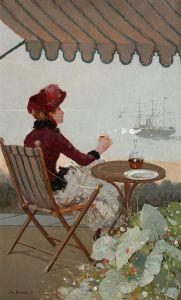
![[Graphic designs for the Modern Art Collector Magazine.] [Medieval festival theme](/imgs/249267/s/winold-reiss-graphic-designs-for-the-modern-art-collector-magazine-medieval-festival-theme-e21959d.jpg)
![Design for fine art print, ‘The Mad Dancer’.] [Original study for woodcut print](/imgs/249285/s/winold-reiss-design-for-fine-art-print-the-mad-dancer-original-study-for-woodcut-print-636dd80b.jpg)
![Designs for lamps with triangular shades.] [Design with white, red, and metallic silver](/imgs/249315/s/winold-reiss-designs-for-lamps-with-triangular-shades-design-with-white-red-and-metallic-silver-40bb661.jpg)
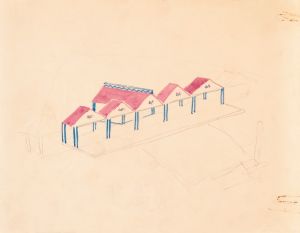
![Drawings for proposed decorations of Mike Lyman’s Restaurant, 424 W. Sixth St. Los Angeles, CA.] [Scheme 1; elevation – K – showing bar](/imgs/249336/s/winold-reiss-drawings-for-proposed-decorations-of-mike-lymans-restaurant-424-w-sixth-st-los-angeles-ca-scheme-1-elevation-k-showing-bar-6d934644.jpg)
![Interior design sketches for Alamac Hotel, 71st and Broadway, New York, NY.] [Study for living room suite](/imgs/249366/s/winold-reiss-interior-design-sketches-for-alamac-hotel-71st-and-broadway-new-york-ny-study-for-living-room-suite-4619965b.jpg)
![Interior perspective drawings of Hotel Siwanoy, Mount Vernon, NY.] [Interior perspective of dining room](/imgs/249368/s/winold-reiss-interior-perspective-drawings-of-hotel-siwanoy-mount-vernon-ny-interior-perspective-of-dining-room-d26480cd.jpg)
![Design for Cincinnati Union Terminal.] [Study for the color treatment of the ceiling](/imgs/249410/s/winold-reiss-design-for-cincinnati-union-terminal-study-for-the-color-treatment-of-the-ceiling-5366bd83.jpg)
![Designs for restaurant and bar interiors with curving bars and stairways.] [Sketches for bars and restaurants](/imgs/249417/s/winold-reiss-designs-for-restaurant-and-bar-interiors-with-curving-bars-and-stairways-sketches-for-bars-and-restaurants-195836c8.jpg)
![Designs for theater with black-framed proscenium and boldly colored settings.] [Study for stage light wall decoration, possibly for Caf ̌Crillon](/imgs/249419/s/winold-reiss-designs-for-theater-with-blackframed-proscenium-and-boldly-colored-settings-study-for-stage-light-wall-decoration-possibly-for-caf-crillon-8d25205e.jpg)
